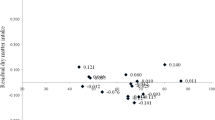Abstract
Residual feed intake (RFI) is the difference between the actual and expected feed intake of an animal based on its body weight and growth rate over a specific period. The objective of this study was to determine the RFI of buffalo calves using residuals from appropriate linear regression models involving dry matter intake (DMI), average daily gain (ADG) and mid-test metabolic body weight. Eighteen male Murrah buffalo calves of 5–7 months were selected and fed individually. A feeding trial using ad libitum feeding of total mixed ration (TMR, concentrate/roughage = 40:60) was conducted for 52 days in which the daily DMI, weekly body weight (BW) and growth rate of the calves were monitored. RFI of calves ranged from −0.20 to +0.23 kg/day. Mean DMI (in grams per kilogram of BW0.75) during the feeding trial period was significantly (P < 0.05) lower in low RFI group (79.66 g/kg BW0.75) compared to high RFI (87.74 g/kg BW0.75). Average initial BW, final BW and mid-test BW0.75 did not differ (P > 0.05) between low and high RFI groups. Over the course of a trial period, low RFI group animals consumed 10 % less feed compared to high RFI group of animals, yet performed in a comparable manner in terms of growth rate. Metabolizable energy for maintenance (MEm) was found to be significantly (P < 0.05) lower in low RFI group (13.54 MJ/100 kg BW) as compared to that of high RFI group (15.56 MJ/100 kg BW). The present study indicates that RFI is a promising selection tool for the selection of buffaloes for increased feed efficiency.


Similar content being viewed by others
References
AOAC. 2005. Official Methods of Analysis, 18th edition. Association of Official Analytical Chemists, Washington, DC, USA
Archer, J.A., Arthur, P.F., Herd, R.M., Parnell, P.F. and Pitchford, W.S., 1997. Optimum post weaning test for measurement of growth rate, feed intake, and feed efficiency in British breed cattle. Journal of Animal Science, 75, 2024-203
Arthur, P.F., Renand, G. and Krauss, D., 2001. Genetic and phenotypic relationships among different measures of growth and feed efficiency in young Charolais bulls. Livestock Production Science, 68, 131-139
Baker, S.D., Szasz, J.I., Klein T.A., Kuber P.S., Hunt, C.W., Glaze Jr J.B., Falk, D., Richard, R., Miller, J.C., Battaglia, R.A. and Hill, R.A., 2006. Residual feed intake of purebred Angus steers: Effects on meat quality and palatability. Journal of Animal Science, 84, 938-945
Basarab, J.A., Price, M.A., Aalhus, J.L., Okine, E.K., Snelling, W.M. and Lyle, K.L., 2003. Residual feed intake and body composition in young growing cattle. Canadian Journal of Animal Science, 83, 189-204
Borghese, A. and Mazzi, M., 2005. Buffalo Population and Strategies in the World. Buffalo Production and Research. 1–39 in Borghese, A. (ed.) REU Technical Series 67. Inter-regional Cooperative Research Network on Buffalo, FAO Regional Office for Europe, Rome.
Crews D. H., Jr., 2005. Genetics of efficient feed utilization and national cattle evaluation: A review. Genetics and Molecular Research, 4, 152–165.
Cruz, G.D., Rodríguez-Sánchez, J.A., Oltjen, J.W. and Sainz, R.D., 2010. Performance, residual feed intake, digestibility, carcass traits, and profitability of Angus-Hereford steers housed in individual or group pens. Journal of Animal Science, 88, 324-329
Gomez, R.R., Bourg, B.M., Paddock, Z.D., Carstens, G.E., Lancaster, P.A., Miller, R.K., Tedeschi, L.O., Lunt, D.K. Moore, S.A. and Delaney, D.S., 2007. Evaluation of feed efficiency in Santa Gertrudis steers and relationship with temperament and feeding behavior. Journal of Animal Science, 85, 454-455
Herd, R.M., Oddy, V.H. and Richardson, E.C., 2004. Biological basis for variation in residual feed intake in beef cattle. I. Review of potential mechanisms. Australian Journal of Agricultural Research, 44, 423-430
ICAR, 2013. Nutrient composition of Indian feeds and fodders, 1st edn, Indian Council of Agricultural Research and National Institute of Animal Nutrition and Physiology.
Johnston, D.J., Herd, R.M., Reverter, A. and Oddy, V.H., 2001. Heritability of IGF-I in beef cattle and its association with growth and carcase traits. Proc. Assoc. Adv. Animal Breeding and Genetics, New Zealand, 14, 163-166.
Kelly, A.K., McGee, M., Crews, Jr. D.H., Sweeney, T., Boland, T.M. and Kenny, D.A., 2010. Repeatability of feed efficiency, carcass ultrasound, feeding behaviour, and blood metabolic variables in finishing heifers divergently selected for residual feed intake Journal of Animal Science, 88, 3214-3225.
Licitra, G., Harnandez, T.M. and Van Soest, P.J., 1996. Standardizations of procedures for nitrogen fractionation of ruminant feeds. Animal Feed Science and Technology, 57, 347-358.
McQueen, R.E. and Nicholson, J.W.G., 1979. Modification of the neutral-detergent fibre procedure for cereals and vegetables by using an alpha-amylase. Journal of the Association of Official Analytical Chemists, 62, 676.
Moore, K.L., Johnston, D.J., Graser, H.U. and Herd, R.M., 2005. Genetic and phenotypic relationships insulin-like growth factor-I (IGF-I) and net feed intake, fat, and growth traits in Angus beef cattle. Australian Journal of Agricultural Research, 56, 211-218.
Nkrumah, J.D., Okine E.K., Mathison G.W., Schmid K., Li, C., Basarab J.A., Price, M.A., Wang, Z. and Moore, S.S., 2006. Relationships of feedlot feed efficiency, performance, and feeding behaviour with metabolic rate, methane production, and energy partitioning in beef cattle. Journal of Animal Science, 84, 145-153.
NRC, 2001. Nutrient Requirements of Dairy Cattle.7th Revised Edition. National Academy Press, Washington, DC.
SAS Institute, Inc. 2003. SAS user’s guide: Statistics, SAS Institute, Inc., Cary, NC. Version 9.2.
Acknowledgments
The authors would like to express their sincere thanks to the director of the institute for providing necessary facilities.
Conflict of interest
The authors declare that they have no conflict of interest.
Author information
Authors and Affiliations
Corresponding author
Rights and permissions
About this article
Cite this article
Subhashchandra bose, B.K., Kundu, S.S., Tho, N.T.B. et al. Residual feed intake as a feed efficiency selection tool and its relationship with feed intake, performance and nutrient utilization in Murrah buffalo calves. Trop Anim Health Prod 46, 615–621 (2014). https://doi.org/10.1007/s11250-014-0536-2
Accepted:
Published:
Issue Date:
DOI: https://doi.org/10.1007/s11250-014-0536-2



